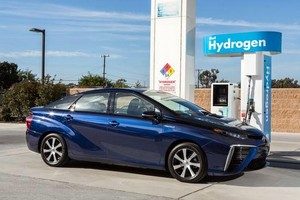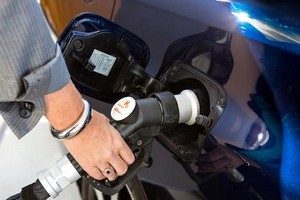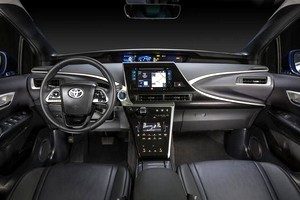Powered by Hydrogen, Electricity, and Dreams
The 2017 Toyota Mirai is a rare bird on the roadways today, but that’s not what the State of California or the Toyota Motor Company have in mind for the future. The Mirai, Toyota’s hydrogen-powered technology testbed, is a remarkably normal midsize sedan that you can drive now, at least if you live in the urban areas of California.

Electric vehicles like the Nissan Leaf, BMW i3, or Volkswagen e-Golf are commonplace in traffic these days in California. The new Chevrolet Bolt EV’s sales are accelerating. But driving a hydrogen car is way cooler than that–it makes you a real early adopter.
Ever since it introduced the first Prius 20 years ago, Toyota has been working on hydrogen fuel cells. Now, at last, you can sample their wares in a real car.
The Hydrogen Path
There is some complicated technology under the hood. You can go to Toyota’s website to learn more, but the basic story is that instead of an engine burning gasoline, there’s a fuel cell. It takes compressed hydrogen fuel, passes it through a membrane to join oxygen from the air. This molecular-level attraction creates energy, which is then fed to electric motors to power the car. It’s very quiet, and the only emission is the resulting H2O–water.
The hydrogen is stored in two high-pressure tanks under the car. To add fuel, you simply pull into the nearest station. They are scarce, but there are three within 10-15 minutes of my house. The closest, in Hayward, is on my way to work. Although the window sticker in my Celestial Black test car said it had a 312-mile range, when I filled the car, it topped out at 249 miles. You can fill up in about five minutes, just like you do with a regular gasoline car.

The tanks at the station are a bit different from a regular gas station. The filler on the car is a narrow, protruding nozzle. The dispenser is heavier than a gasoline filler. It slides over the car’s filler and latches down into place. With 10,000 psi, you need to be sure it’s secure. Then, you lift the lever on the pump and, with a whoosh, the filling begins. You’ll see some frozen condensation on the handle, because the hydrogen is cold.
Two Stations; Two Experiences
I visited two different stations. The first was the brand new one in San Ramon. The Linde company, a national supplier of gases, built this one (with state funding), and it’s a parklike beauty with large trees around it and very minimal signage. The storage tank looms behind a cement wall.

I pulled in and watched the introductory video on a screen on the tank to be sure I was following the instructions, and then started the fill up process. When the numbers were done accumulating, I’d added about 220 miles of driving range for $65.20. Whew, that’s expensive! The hydrogen fuel is measured in Kg, so it’s hard to equate it to gasoline, which is why I gave the range. (Ed note: For comparison, a 2017 Toyota Prius at $3.50/gallon for gas, would cost a little more than $7.00 to get the same range.)
I had some trouble disconnecting the fuel nozzle from my car, but the instructions told me to just wait a few minutes if that occurred, and it did work out. I also called Linde; they returned my call later and explained it a bit more. There is a special way to remedy this issue, but it sounds like there are still a few little bugs in the refueling process.
Two gentlemen, each driving brand new Honda Clarity fuel cell cars, pulled in behind me, so I wasn’t alone out there. The only other fuel cell option now is Hyundai’s Tucson fuel cell, a compact crossover that you would never identify as a fuel cell vehicle, since it looks identical to the gasoline-powered model.
My second refueling visit, at a True Zero station in Hayward, went smoothly. I knew the drill, so I didn’t watch the video, but some basic instructions walked me through the process on the screen. This station was part of a Mobil gas station, an arrangement that makes it easier to build, I assume, and may be part of the long-term plan. In this case, the bill came to $53.01 (I bought a little less), and the nozzle came off right away. I smiled.
More Stations Coming
The State of California, through the California Fuel Cell Partnership (www.cafcp.org), is working to build an infrastructure of 100 stations in the state. There are 31 open now. This scarcity could be an issue if you wanted to travel widely with your hydrogen car. Visit their website for a load of great information, including an interactive map showing the nearest hydrogen stations and information about them (such as whether they’re operational, which could make a big difference).

There are two other issues that make hydrogen cars something of an adventure for the few. The price for my test car, a single model with no options, came to $58,335, including shipping. But that’s not the way you want to get yours. Currently, you can put $2,499 down and pay $349 a month for a lease. And Toyota will throw in $15,000 worth of free fuel. So, with no maintenance or fuel costs, you’ve got a pretty sweet deal.
The other issue isn’t a practical or financial one, but an environmental one. Hydrogen isn’t found unmixed with other atoms. You have to make hydrogen fuel, and it takes a lot of energy to do it. Many methods are being investigated, but if it’s not made with methane from trash or with solar or wind power, it’s not that clean yet. Although water is the only byproduct from the car itself, the entire system has a way to go. Finally, the fuel must be delivered to the stations, adding further fuel consumption to the process. None of the delivery trucks are hydrogen powered yet.
Back To the Car
What’s the car like? Well, it’s about the size of Toyota’s popular midsize Camry sedan on the outside, but about 15 cubic feet smaller inside, so it’s actually a subcompact per the EPA. It feels comfortable up front, but there is room for only two passengers in back, with less legroom than the Camry. The trunk is only 12.8 cubic feet versus 15.1 for the Camry, thanks to some space taken for the battery and hydrogen storage tanks.

Styling is a bit extreme, but it’s part of the design language used by all new Toyotas, so it looks more conventional now than when it debuted a couple of years ago. The sweeps along the sides, large air collectors in the lower corners of the front, and drooping taillamps no longer jar the eye. Inside, the dash and doors swoop across, with the three layers of controls displayed on flat, glossy black panels. Just the edge of futuristic.
The driving experience is pretty normal, too, with adequate, but not ferocious acceleration. With 151 horsepower and 247 pounds-feet of torque from the electric motor, it’ll go from zero to sixty in nine seconds. The car outweighs the Camry by about 700 pounds, so it feels less light on its feet. The seats, in SofTek, approximate leather without killing any cows.
The Mirai employs the fuel cell and a battery, so, as in Toyota’s Prius and other hybrids, you can view on a screen where the energy comes from and where it’s going. You may be driving in town on just battery power, or moving down the freeway only on the fuel cell itself. Or it could be both. The Mirai’s computer switches back and forth as the need arises. The electricity in the battery is regenerated when you’re braking, slowing down or rolling downhill, as in other electric vehicles. There’s no plug.
You can also learn about how ecologically you’re driving, based on the Mirai’s rating system. It assesses how well you accelerate, cruise and brake and assigns a score, divided by 100—essentially a percentage. My best was 58/100. I was driving as well as I could, so I’m not sure what would make me better.

The EPA gives the Mirai ratings of 67 MPGe city/highway/combined. MPGe is an equivalent, so you can compare it with other electric vehicles. I averaged 60.1 MPGe over the test week. The EPA green scores are perfect 10s, of course.
So, to sum up, the Mirai is pleasant, easy to live with, and with Toyota’s fuel and service deal, fairly inexpensive to drive for three years. You can be part of the latest wave of high tech while blending into traffic. Are you up for a new automotive adventure? Time will tell if there will be enough adoption of this technology to make it successful in the long run.
In order to give you, the reader, the best perspective on the many vehicles available, Clean Fleet Report has a variety of contributors. When possible, we will offer you multiple perspectives on a given vehicle. We hope you’ll enjoy these diverse views–some are just below—and let us know what you think in comments below or at publisher@cleanfleetreport.com.
Road Test: 2017 Toyota Mirai
First Drive: 2016 Toyota Mirai
News: Toyota Mirai Seeks To Be Prius of Fuel Cell Vehicles
Related Stories You Might Enjoy:
News: GM Show Autonomous Fuel Cell Platform
News: Mercedes GLC Fuel Cell
First Drive: 2017 Honda Clarity Fuel Cell
Disclosure:
Clean Fleet Report is loaned free test vehicles from automakers to evaluate, typically for a week at a time. Our road tests are based on this one-week drive of a new vehicle. Because of this we don’t address issues such as long-term reliability or total cost of ownership. In addition, we are often invited to manufacturer events highlighting new vehicles or technology. As part of these events we may be offered free transportation, lodging or meals. We do our best to present our unvarnished evaluations of vehicles and news irrespective of these inducements.
Our focus is on vehicles that offer the best fuel economy in their class, which leads us to emphasize electric cars, plug-in hybrids, hybrids and diesels. We also feature those efficient gas-powered vehicles that are among the top mpg vehicles in their class. In addition, we aim to offer reviews and news on advanced technology and the alternative fuel vehicle market. We welcome any feedback from vehicle owners and are dedicated to providing a forum for alternative viewpoints. Please let us know your views at publisher@cleanfleetreport.com.

6 thoughts on “Road Test: 2017 Toyota Mirai”